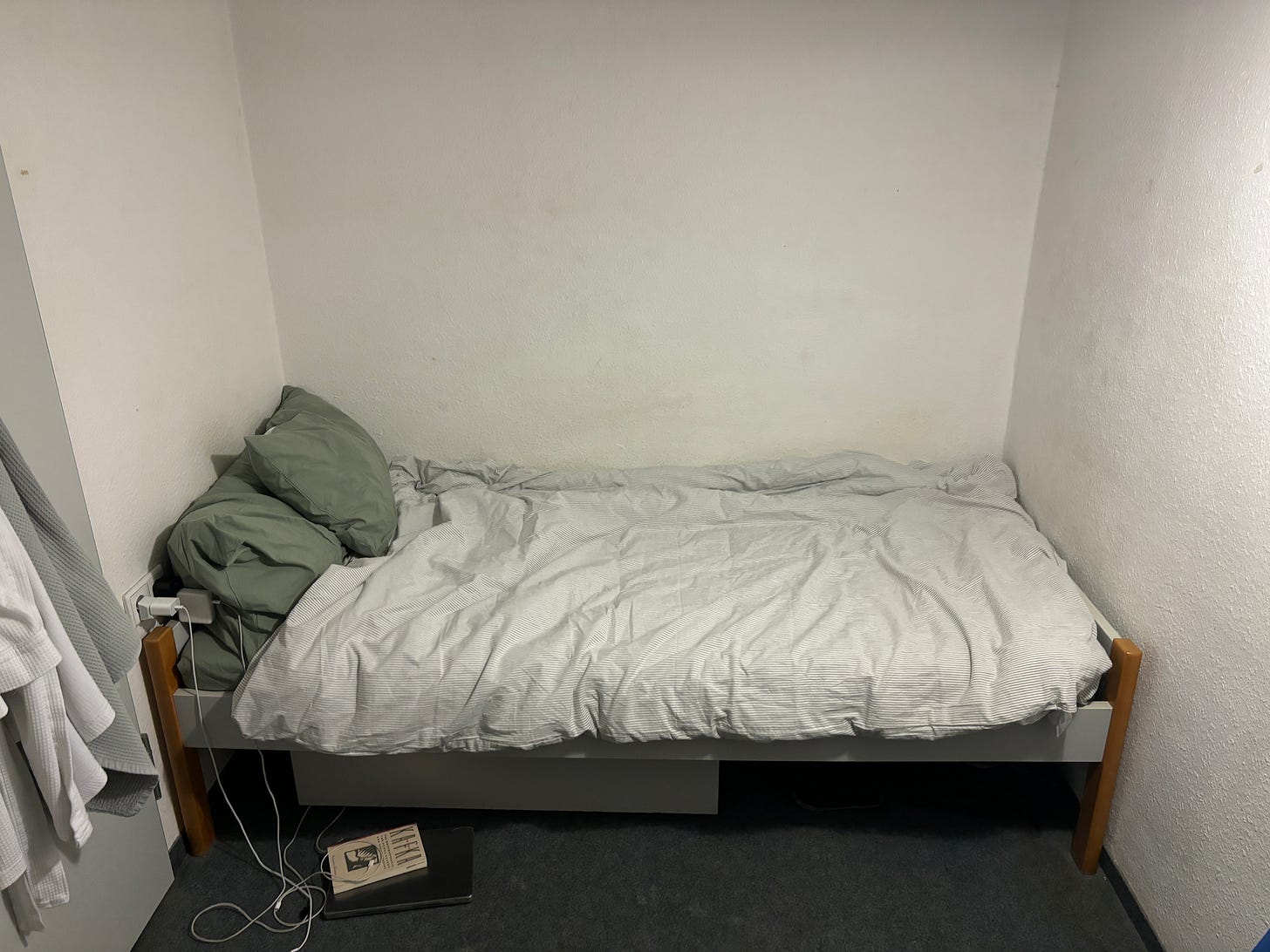Back in the GDR...
In honor of German Unity Day, a look inside my distinctly Soviet-era student accommodation.
DRESDEN, Germany – In mid-September, I moved into an austere single room on the fifth floor of Budapester Straße 22, a residence hall that houses about 160 students.
My carpeted room is simply furnished, with just a twin bed, an armoire, some shelving and an oversized desk.
My friend Alisha, an English teacher from the UK, told me that during the German Democratic Republic era, each room slept six. My desk is about the size of my bed, so I can envision where at least two of the bunks would have gone.

Alisha, who has lived in Saxony for more than three years now, used to live in Budapester Straße 24, the nearly identical twin of Budapester Straße 22. She described life in “Buda,” as she calls it, as “hateful” — her Yorkshire catch-all for anything less than ideal. But we agreed: the rent is so cheap it’s worth it.
I can’t imagine what $300 a month in a comparable American city would afford me. (For reference, Dresden’s population is around 560,000 — similar to Baltimore or Milwaukee.)
My room’s one large window faces southwest toward the small Saxon town of Freital. Towers from a nearby plant dominate the view, and the city’s main rail yard sprawls beyond my window. From here, I can see trains rumbling in and out of the city.
I can also see Budapester Straße 24 from my window. Both Budapester Straße 22 and Budapester Straße 24 — plain, blocky, white buildings nearly indistinguishable from one another — betray a certain Soviet sensibility.
Unlike Dresden’s meticulously restored Altstadt, which I’ve been told locals fought to shield from redevelopment during the Soviet era, this part of town bears visible reminders of Dresden’s former status as a preeminent GDR city.
The rail yard and a shopping mall separate these nondescript, utilitarian dorms from the picturesque city center’s churches and squares. Much of Dresden’s Altstadt was rebuilt only after German reunification, which officially happened 34 years ago today.
I’m about 20 minutes from the Altstadt if I walk briskly. The Neustadt — where Dresden’s cool, young people hang out and pretend they live in Berlin — is farther.
When I tell people I live on Budapester Straße, I can usually sense their confusion. It’s not a residential street, and it’s not convenient to the university — or really much else for that matter. But I am just a five-minute walk from an incredibly average bakery, a döner shop and a Lidl.
The nearest tram stop — where I can catch a ride into the Altstadt and Neustadt — is actually under Budapester Straße, a major four-lane road. To get from the platform to my dorm, I take stairs up from the rail yard and onto the overpass that bridges the train tracks. With little else around, the pair of dorms looms over Budapester Straße.

Each floor of Budapester Straße 22 has two hallways, each of which has eight single bedrooms, two bathrooms and two kitchens.
The heavy doors to students’ rooms tend to stay firmly shut, at least on my hall. They don’t even offer a sliver of light underneath, so it’s hard to tell how many of the rooms are occupied. So far, I’ve only met one of my neighbors.
Sometimes I can hear strains of music or conversation from other rooms, and as the start of the semester draws nearer, there is more activity in the dorm’s corridors and lobby. When I first moved in, the building was nearly silent.
It’s a far cry from my college friends’ new apartments in New York and Chicago. Unfortunately for me, I couldn’t be picky about having a swimming pool or a doorman when I was searching for a place to live in Dresden. But even if I were living in the States right now, I’m sure I’d have to forgo many luxuries on a journalist’s pay anyway.
Still, I wouldn’t have guessed that I’d spend more time living in a dorm at 22 than I did at 18 — or just how different dorm life would feel in Germany.
But while my freshman dorm at Northwestern may have had a livelier social scene, it definitely didn’t have a bar on its ground floor like Budapester Straße 24 does. Club Traumtänzer hosts Dungeons and Dragons tournaments and boasts Dresden’s most extensive selection of meads.
I have yet to check it out, but I’ll report back when I do. ▣



Excellent dispatch and writing. Can't wait till the next update.